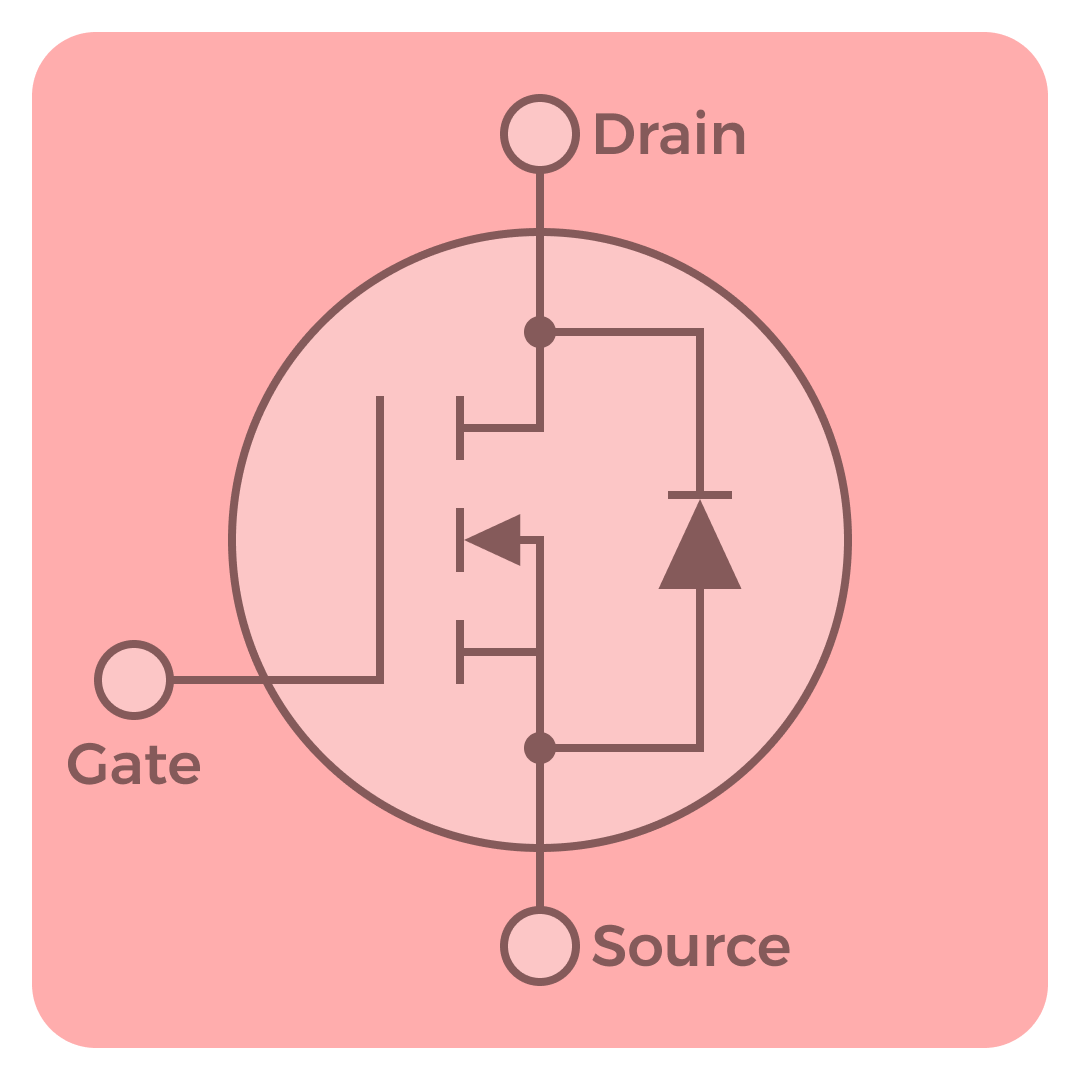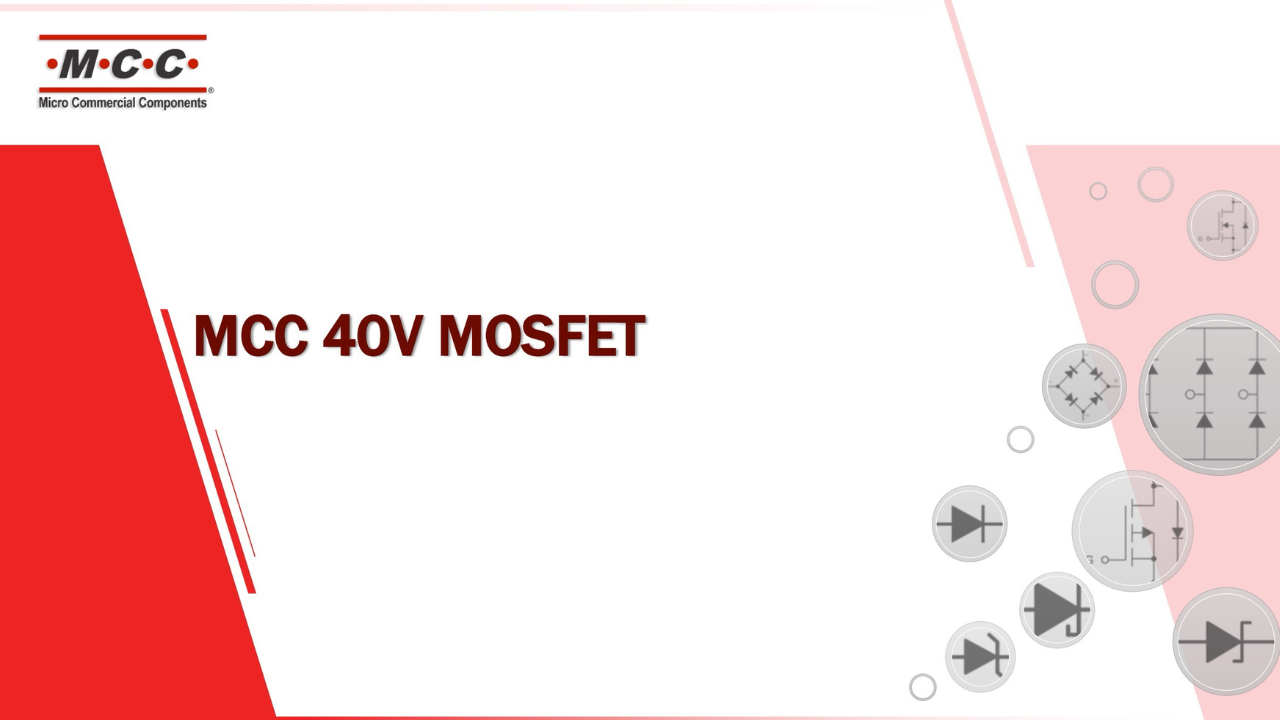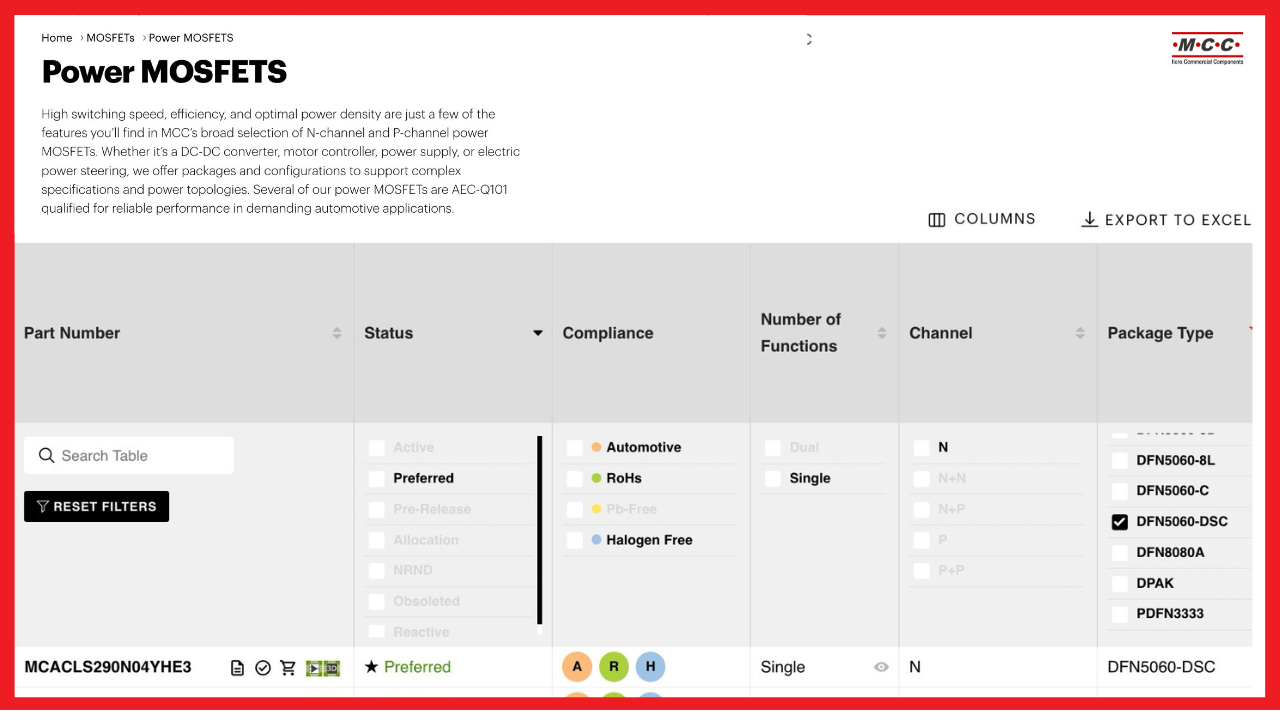The Essential Guide to 40V MOSFET Functions & Features
From the Basics to an In-Depth Look at 40V Options
From the Basics to an In-Depth Look at 40V Options
Crucial components across a diverse range of applications, 40V MOSFETs are particularly useful in automotive systems and power management solutions. These versatile devices play key roles in motor drives, DC-DC converters, and battery management systems, enabling efficient operation and reliable performance.
What sets 40V MOSFETs apart? Their ability to manage moderate voltage levels while delivering low on-resistance and high-current capacity — a combination that makes them indispensable for engineers seeking optimal solutions for efficiency and stability.
This guide will explore the fundamental principles behind MOSFETs and their various types and classifications, highlighting the specific advantages of 40V components in modern electronics.
What is a MOSFET?

The term MOSFET stands for metal-oxide-semiconductor field-effect transistor. Serving primarily as switching devices or amplifiers, these components are a must for electronic circuits. Unlike bipolar junction transistors, a MOSFET's channel width or amplification gain is controlled by gate-to-source voltage rather than current. This feature enhances efficiency and reliability, making them integral to various applications.
How Does a MOSFET Work?
A MOSFET operates by using an electric field to control the flow of current. It has three primary terminals: gate, drain, and source. The voltage applied to the gate terminal regulates the conductivity between the drain and source terminals, which either permits or blocks the flow of current.
MOSFET Types and Classifications
| Classification | Voltage | Technologies |
|---|---|---|
| LV Low Voltage |
12V ~ 30V | Trench |
| MV Medium Voltage |
40V ~ 200V | Trench, SGT |
| HV High Voltage |
> 400V | Super Junction |
- Low Voltage (12V to 30V): Ideal for small signal devices, this category typically employs trench structure technologies to enhance performance and reliability.
- Medium Voltage (40V to 200V): This range utilizes advanced designs such as split and shielded gate trench configurations, offering improved dynamic performance in power packages for a variety of applications.
- High Voltage (400V and above): Designed for handling demanding applications, high voltage MOSFETs implement super junction structural designs that effectively manage higher voltage levels while maintaining efficiency.
Working knowledge of these classifications leads to better decision-making when specifying the right MOSFETs for electronic devices and systems.
MOSFET Technologies: Trench vs. Split-Gate Trench
.png?width=600&height=300&name=tench%20vs%20split-gate%20trench%20mcc%20semi%20micro%20commercial%20components%20(1).png)
Here’s a closer look at these technologies:
Trench MOSFETs
Definition and Working Principle: Trench MOSFETs are characterized by their vertical structure, with the gate embedded in the silicon to form a “trench.” This design significantly reduces on-resistance and enhances current capacity, allowing for a more efficient flow of electricity.
Advantages:
- Low On-Resistance: Helps minimize energy loss during conduction, leading to improved efficiency.
- High Current Capacity: Well-suited for high-power applications due to less heat generation.
Applications: Trench MOSFETs are widely used in low-voltage power supplies, automotive systems, small-signal conversion, and other applications that require effective power management and conversion.
Split-Gate Trench MOSFETs
Definition and Working Principle: Split-gate trench MOSFETs feature a gate structure embedded deep within the epitaxial layer of silicon. By increasing the electric field area, this configuration enhances breakdown voltage and reduces gate charge.
Advantages:
- Improved Dynamic Performance: Achieves faster switching speeds thanks to lower reverse transfer capacitance.
- Lower Gate Charge: Requires less energy for switching, improving overall efficiency.
Applications: Ideal for high-frequency applications where rapid switching is crucial, such as advanced power supplies and high-speed communication devices.
Additional Benefits of Split-Gate Trench Design: Beyond enhanced performance, the split-gate trench design allows for a smaller die size, which lowers manufacturing costs and supports more compact device designs. This makes them particularly valuable in applications that require both efficiency and space savings.
Trench and split-gate trench technologies each have benefits that could make them best suited for the project at hand, so knowing when to use each is beneficial to optimal outcomes.
MCCs 40V MOSFET Portfolio Overview
Because MOSFETs — particularly the 40V options — are essential in modern electronics, MCC offers a comprehensive portfolio with over 75 products available. Our 40V MOSFET lineup includes both automotive and non-automotive components, ensuring versatility and efficiency across various sectors and applications.
MCC’s entire MOSFET selection includes more than 600 devices, with over 400 power MOSFETs and over 200 small signal MOSFETs. We offer several configurations to support diverse needs, such as single N-channel, single P-channel, dual N-channel, dual P-channel, and N+P channel.
.png)
What are the Different Types of MOSFET Packages?
MCC offers a wide range of packaging options to accommodate various design requirements. Each package type is tailored for specific applications, ensuring optimal performance and reliable operation. The different types of MOSFET packages available include:
- DFN Packages: DFN (Dual Flat No-lead) packages feature a compact design that is ideal for space-constrained applications, especially in the automotive sector. MCC provides several sizes, including:
- DFN2020: Measures 2mm x 2mm, perfect for small electronic devices where real estate is at a premium.
- DFN3333: With dimensions of 3.3mm x 3.3mm, it offers a balance between size and performance for moderate power applications.
- DFN5060: This larger package measures 5mm x 6mm, making it suitable for applications requiring higher current handling.
- DPAK and D2PAK Packages: DPAK (Decawatt Package) is designed for medium-power applications, while the D2PAK (Double Decawatt Package) is designed for high-current and high-power applications. Robust construction allows for better thermal performance and electrical efficiency, making these packages popular choices in automotive and industrial sectors. The larger footprint provides ample surface area for heat dissipation, which is mission-critical for maintaining performance under demanding conditions.
- TOLL Packages: The TOLL (TO-Leadless) package is engineered for high-current automotive and industrial applications. It delivers multiple benefits, including excellent thermal performance, high current carrying capacity, and outstanding EMI behavior. Factor in the low-profile, space-saving design, and the TOLL delivers the utmost efficiency and improved reliability in a high power density package.
- SOT Packages: SOT (Small Outline Transistor) packages, including SOT-23, are specifically designed for small signal MOSFETs. Compact size makes them ideal for applications where minimal space is available, such as in portable devices and consumer electronics. SOT packages also facilitate efficient routing on PCBs, contributing to overall design compactness.

Choosing the Right MOSFET Package
When selecting a MOSFET package, factors such as application environment, thermal management needs, current ratings, and board space constraints should be considered. Each package type offers distinct advantages that can significantly impact the performance of electronic designs.
Understanding the features and suitability of each packaging option enables more informed decisions that align with project requirements.
Maximizing Performance with Dual-Side Cooling in DFN5060 Packages
Dual-side cooling (DSC) technology represents a significant advancement in MOSFET packaging, particularly for DFN5060 models, commonly referred to as DFN 5x6. This advanced package technology enhances thermal efficiency and current carrying stability, making it ideal for high-power applications.
MCC offers double-sided cooling packages in the compact DFN5x6 form factor. Available in two variants with similar RDS(on) values of 1.1 milliohms, these devices differ in current carrying capacity based on die size. This flexibility allows engineers to choose the most suitable option for their application needs.
One key advantage of DFN5060 dual-side cooling over traditional bottom-cooling designs is superior heat dissipation. Its superior thermal performance has been proven in tests, where the dual-side cooling design showed a temperature rise nearly 20℃ lower than its bottom-cooling counterpart, the traditional DFN5060, at an ambient temperature of approximately 20.5℃ with a current draw of 15 amperes over three hours. Learn more about the DSC DFN5060 comparison with traditional DFN5060 packages in this informative webinar.
Improved thermal management not only enhances MOSFET performance but also increases reliability in demanding environments. By maintaining lower operating temperatures, devices can deliver higher currents without compromising integrity. Therefore, DFN 5x6 double-sides packages are an excellent choice for applications requiring high efficiency and robust performance under heavy loads.
Key Benefits of DFN5060 Dual-Side Cooling
- Lower Temperature Rise: Significantly reduces heat accumulation.
- Enhanced Thermal Margin: Enables higher current capability without overheating.
- Higher Power Dissipation: Improved thermal cooling performance.
- Reduced Junction-to-Heatsink Thermal Resistance: Optimizes thermal management.
By integrating dual-side cooling technology within the DFN5060 package, designers can optimize system performance while minimizing overheating risks.
Practical Applications of 40V Power MOSFETs
What Types of Applications Are Suitable for 12 V-40 V N-Channel MOSFETs?
N-channel MOSFETs with a voltage range of 12 V-40 V are versatile components tailored for a multitude of applications. Here’s a closer look at where these devices excel:
- DC Motor Drives: They are crucial in controlling the speed and torque of motors, making them perfect for automation and robotics industries.
- Battery-Powered Systems: With their efficient switching capabilities, these MOSFETs enhance performance in battery management systems, ensuring longer life and reliability.
- Load Switches: Used to regulate power flow, they offer dependable operation in various electronic devices, safeguarding against overcurrent conditions.
- Compact Electronics: Their small footprint and strong thermal performance make them ideal for integration into compact, space‑constrained electronic devices that demand efficient, reliable power switching.
Applications in Automotive Electronics
Modern vehicles are becoming increasingly sophisticated, incorporating advanced safety features that add complexity. Among the key components driving this innovation are MOSFETs, which play a crucial role in various automotive applications. They are extensively utilized for functions such as electric oil pumps, water pumps, power steering, and power seats. Additionally, MOSFETs are vital in DC-DC converters and battery management systems, ensuring efficient power distribution and management within 12V vehicle systems.
A notable example is the Automotive-Grade DFN5060 MOSFET, which features dual-side cooling to enhance performance and reliability in demanding automotive environments.

Non-Automotive Applications and Performance
In non-automotive sectors, 40V MOSFETs are well-suited for applications in power tools, DC fans, home appliances, battery management systems (BMS), and DC-DC converters. Helping in switching control and protection tasks, they guarantee stability and efficiency across various devices and systems.

MCC’s 40V MOSFETs for Automotive and Non-Automotive Offerings
MCC's Automotive 40V Power MOSFETs
| Part Number | MCACL 280N04YHE3 |
MCAC 180N04YHE3 |
MCAC 120N04YHE3 |
MCAC 95N04YHE3 |
MCAC 88N04YHE3 |
MCACD 60N04YHE3 |
|---|---|---|---|---|---|---|
| Configuration | N | N | N | N | N | N+N |
| RDS(ON) (mΩ) (Typ.) (Max.) | 0.6 0.8 |
1.50 2.00 |
2.40 3.10 |
2.40 3.20 |
3.50 4.50 |
4.20 5.50 |
| VGS(th) (V) (min. - max.) (typ.) | 2.0 – 4.0 2.8 |
2.0 – 4.0 3.1 |
2.0 – 4.0 3.1 |
2.0 – 4.0 2.8 |
2.0 – 4.0 2.8 |
2.0 – 4.0 3.1 |
| ID @25ºC (A) | 280 | 180 | 120 | 95 | 88 | 60 |
| QG (nC) typ. | 79 | 56 | 38 | 27.7 | 15.6 | 15.6 |
| TJ (ºC) | -55 to +175 | -55 to +175 | -55 to +175 | -55 to +175 | -55 to +175 | -55 to +175 |
| Part Number | MCACL 320N04YQ | MCACL 330N04YHE3 | MCACL 220N04YHE3 | MCAC 130N04YHE3 | MCAC 125N04YHE3 | MCAC 85N04YHE3 | MCAC 75N04YHE3 | MCACD 55N04YHE3 |
|---|---|---|---|---|---|---|---|---|
| Configuration | N | N | N | N | N | N | N | N+N |
| RDS(ON) (mΩ) (Typ.) (Max.) | 0.85 1.10 |
0.80 1.00 |
0.95 1.30 |
1.50 1.75 |
2.00 2.60 |
4.30 6.00 |
5.20 6.80 |
6.50 8.50 |
| VGS(th) (V) (min. - max.) (typ.) | 2.0 – 3.0 2.5 |
2.0 – 4.0 2.8 |
1.0 – 2.5 1.7 |
1.2 – 2.5 1.7 |
2.0 – 4.0 3.0 |
2.0 – 4.0 3.0 |
2.0 – 4.0 3.0 |
2.0 – 4.0 3.0 |
| ID @25ºC (A) | 320 | 330 | 220 | 130 | 125 | 85 | 75 | 55 |
| QG (nC) typ. | 88 | 133 | 131 | 129 | 42 | 19 | 13 | 13 |
| TJ (ºC) | -55 to +175 | -55 to +175 | -55 to +175 | -55 to +175 | -55 to +175 | -55 to +175 | -55 to +175 | -55 to +175 |
| Part Number | MCGWF 45P04HE3 |
MCGWF 60N04YHE3 |
|---|---|---|
| Configuration | P | N |
| VDS (V) | 40 | 40 |
| RDS(ON) (mΩ) (Typ.) (Max.) | 10 13 |
3.00 3.90 |
| VGS(th) (V) (min. - max.) (typ.) | 1.0 – 3.0 1.6 |
2.0 – 4.0 3.0 |
| ID(A) @25ºC | 45 | 60 |
| QG (nC) typ. | 73.4 | 38 |
| TJ (ºC) | -55 to +150 | -55 to +175 |
| Part Number | MCTL 320N04YQ |
MCTL 270N04YHE3 |
|---|---|---|
| Configuration | N | N |
| VDS (V) | 40 | 40 |
| RDS(ON) (mΩ) (Typ.) (Max.) | 0.80 1.10 |
1.00 1.30 |
| VGS(th) (V) (min. - max.) (typ.) | 2.0 – 3.0 2.5 |
2.0 – 4.0 3.0 |
| ID(A) @25ºC | 320 | 270 |
| QG (nC) typ. | 88 | 135.6 |
| TJ (ºC) | -55 to +175 | -55 to +175 |
| MCACLS290N04YHE3 | MCACLS330N04YHE3 | |
|---|---|---|
| VDS | 40V | 40V |
| RDS(on) @ VGS=10V |
typ. 0.85mΩ max. 1.10mΩ |
typ. 0.83mΩ max. 1.10mΩ |
| Qg | typ. 79nC | typ. 115.9nC |
| VGS | ±20V | ±20V |
| VGS(th) | min. 2.0V typ. 2.8V max. 4.0V |
min. 2.0V typ. 2.6V max. 4.0V |
| ID | @ TC=25ºC 290A @ TC=100ºC 205A |
@ TC=25ºC 330A @ TC=100ºC 233A |
| TJ | -55ºC to +175ºC | -55ºC to +175ºC |
| Package | DFN5060-DSC | DFN5060-DSC |
| Dimension | max. 5.30 x 6.70 x 0.76mm | max. 5.30 x 6.70 x 0.76mm |
MCC’s Non-Automotive 40V Power MOSFETs
| Part Number | MCU 45P04B |
MCB 220N04Y |
MCBS 220N04Y |
MCG 50N04 |
MCACL 330N04Y |
MCTL 270N04Y |
|---|---|---|---|---|---|---|
| Configuration | P | N | N | N | N | N |
| RDS(ON) (mΩ) (Typ.) (Max.) | 11 14 |
1.20 1.50 |
0.85 1.10 |
3.3 4.0 |
0.65 0.85 |
1.00 1.30 |
| VGS(th) (V) (min. - max.) (typ.) | -1.0 – -2.3 -1.5 |
2.0 – 4.0 3.1 |
2.5 – 4.5 3.1 |
1.0 – 2.5 1.5 |
2.0 – 4.0 3.2 |
2.0 – 4.0 3.0 |
| ID @25ºC (A) | -45 | 220 | 220 | 50 | 330 | 270 |
| QG (nC) typ. | 58 | 136 | 132 | 102 | 133 | 15.6 |
| TJ (ºC) | -55 to +175 | -55 to +175 | -55 to +175 | -55 to +150 | -55 to +175 | -55 to +175 |
| Package | DPAK | D2-PAK | TO-263-7 | DFN3333 | DFN5060-C | TOLL-8L |
Additional Resources
Discover our extensive collection of documents and resources tailored for power MOSFET selection and design. These materials are crafted to meet the needs of both seasoned professionals and newcomers eager to expand their knowledge.
40V MOSFET Brochure
Download our brochure for a detailed exploration of the 40V MOSFET. Dive into the features and applications that distinguish this technology.
Applications
Explore a range of applications in computing, industrial, consumer devices, and automotive sectors, showcasing the versatility of power MOSFETs in modern technology.
Power MOSFET Catalog
Search through our extensive MOSFET catalog to find the perfect fit for your computing, industrial, consumer device, or automotive project. Our catalog is designed to streamline your selection process with ease and precision.
Contact MCC for advanced solutions that deliver a competitive edge.
MCC is a manufacturer of high-quality discrete semiconductors to the consumer markets © MCC. All Rights Reserved · 2026


